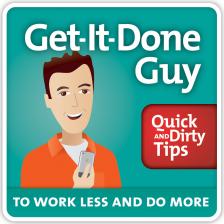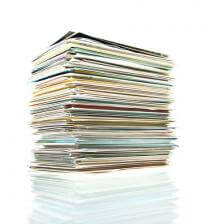How to Work From Your Car
If you have a job that causes you to work from your car, you may find yourself living in clutter. Get-it-Done Guy has tips and tricks for getting organized in a small, mobile space.

“I am a traveling healthcare worker and my car is basically my office. Any tips for those of us in the world of rolling offices to be more efficient and have our car not be so cluttered?”
Ah, Chris, you bring back memories of the good old days. Living in my car, sleeping in the backseat, BBQing over a campfire, having friends crowd into the back seat for a party until 4 am Those were the days…said NO ONE EVER!
The problem with cars is that there just isn’t room for everything we need. You can’t fit filing cabinets, large computer monitors, beer pong tables, or even a disco ball. But yet, we need them to be a productive space.
Sponsor: Visit GoDaddy.com to get your $2.95 .COM domain. Some limitations apply, see website for details.
I haven’t actually run a business out of a car, but here’s how I would organize things (and I love the way you call your business “mobile health care” wink, wink. “Yes, officer, I’m just delivering prescription herbs. And that? That’s just er, talcum powder, to help me deal with, er, chafing”).
Organize Files and Things the Same Way
My mental image of your car is that it’s full of files and paperwork that relates to your clients and your business. It also has assorted rubber hoses, face masks, harnesses, and little devices that make “beeping” sounds when you connect them to a patient, like in the movies.
See also: Declutter with Get-It-Done Guy and the Domestic CEO (Part 1)
Broadly speaking, you need to organize your papers and your things. As I discussed in my episode on keeping your online and offline files in sync, I recommend using the exact same groupings when you organize both the physical and paper items. Those groupings are people, projects, nouns, and verbs, in that order.
Keep Everything Tidy
In a tight space, you want a place for everything and everything in its place. Grab yourself a portable file carrier from your favorite local, independent stationery store. Stock it with a supply of blank file folders, removable file folder labels, and sticky notes. Every time you get some new paperwork, file it in the appropriate file. If you don’t have an appropriate file, create one immediately, and then file the paper in that.
See also: Declutter with Get-It-Done Guy and the Domestic CEO (Part 2)
When you get physical things – equipment, specimen bottles, syringes – “file” those too. Since you can’t fit them in a physical file folder, create an imaginary file. Put a sticky note on the physical object labeled with the name of the person or project it belongs to. Physically put it by other objects that have sticky notes with the same imaginary file name. But what should the files be?
Group by person. Since your job is oriented around patients, have a file folder – real or virtual – for each person you must deal with. When you get paperwork, take notes, or do anything involving that person, file the paper in that person’s folder. When you visit a patient or need to consult about a patient, just pull that person’s file and you have everything involving them at your fingertips. Put all the physical items that person will need in one place, so when you visit them, you can just grab the syringes, bandages, splints, oxygen tanks, tongue depressers, nose plugs, and supersonic ear wax remover and march right into the house, ready for some exciting home medical action.
-
Group by projects. You may find you have projects that need files. If you’re on a drive to clean the ear canals of everyone who lives within 3 miles of the Happy Brook Waste Processing Center, you have things that relate to the project, but not to any one patient. For example, the list of names and addresses, the reference sheet listing symptoms of ear contamination, and the all-important liability release forms. Put those together in a file labeled “Happy Brook Ear Project.” The file corresponds to a project, not a patient.
-
Group by nouns. Nouns are people, places, or things. You’ve already dealt with persons. Anything that isn’t a person or a project may have information to organize. You need to put the instruction manual for the new supersonic ear wax removal device somewhere. Where appropriate, create paper and virtual files for each noun that you have in your car.
-
Group by verbs. Finally, anything that isn’t a person, project, or noun can be filed by verb. In your case, the verbs will probably be medical procedures. If there’s a procedure for transplanting unused ear wax from a healthy donor to a frail patient, you could create a file called “Ear wax transfer.” In that file put the instructions for the procedure. You might also have a file for the ear wax transfer pump, which has the pump instructions, and the pump itself with the little sticky note that says “Ear wax transfer pump” in your virtual, physical file.
Group by Lifetime
Sometimes things may fall into two areas. If only one patient, Alouicious, uses the ear wax transfer procedure, then the ear wax pump manual could belong in Alouicious’s file, since that’s the only time you’ll use it. Or the pump could go in an “ear wax pump” manual. Which is appropriate?
File things in the file whose lifetime is the same. If Alouicious moves on or gets better, you’ll take Alouicious’s file out of your car. But you’ll still have the ear wax pump, which will need a manual. And if Alouicious stays on but no longer needs the pump, you’ll take the pump out and should take out the manual with it. The ear wax pump manual belongs in the file with the pump, because the lifetimes match.
See also: 6 Rules for an Organized Home
When the ear wax transfer pump breaks, you’ll have no more use for the manual, since the replacement pump comes with a new manual. When the ear wax transfer procedure is superceded by a new procedure, however, you’ll still have the machine, which might be useful for certain kinds of acne treatment. The manual’s lifetime corresponds to the machine not the procedure, so it should be filed under the same file name as the pump, not the procedure.
Prune Regularly

Organize your car like you’d organize an office. Have files for papers and virtual files for objects. Name them the same if they go together. Group files by person, project, thing, or action, as is most appropriate. And when something could go in multiple files, choose the file with the matching lifetime. Good luck! And don’t run out of gas!
Car keys and stack of paper photos courtesy of Shutterstock



